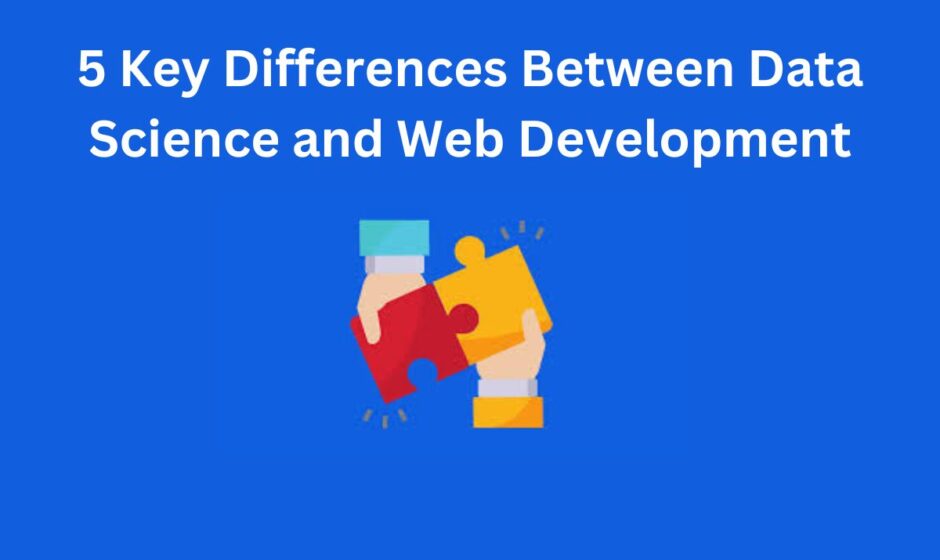Data science and web development are two dynamic fields in technology, each serving unique purposes. Data science focuses on extracting insights from data to drive decision-making, while web development involves creating and maintaining websites and applications. Understanding the key differences between these domains can help individuals choose the right career path and organizations effectively leverage talent for their specific needs.
Five Key Differences Between Data Science and Web Development
1. Definition and Focus
Data Science: Data science is an interdisciplinary field that combines statistical analysis, programming, and domain expertise to extract insights and knowledge from data. It focuses on analyzing complex datasets to uncover patterns, trends, and relationships, enabling organizations to make informed decisions.
Web Development: Web development refers to the process of building and maintaining websites and web applications. It encompasses everything from designing user interfaces to server-side scripting. The primary focus is on creating functional, user-friendly websites that effectively serve their intended purpose.
Key Takeaway:
- Data Science aims to derive insights from data.
- Web Development is about creating and maintaining web applications.
2. Core Skills and Tools
Data Science: Professionals in data science typically require a strong background in mathematics, statistics, and programming. Common tools and languages include:
- Programming Languages: Python, R, and SQL.
- Data Manipulation Tools: Pandas, NumPy, and SciPy.
- Machine Learning Frameworks: TensorFlow, Keras, and Scikit-learn.
- Data Visualization Tools: Tableau, Matplotlib, and Seaborn.
Web Development: Web developers focus on different skill sets tailored to building web applications. Key skills and tools include:
- Frontend Technologies: HTML, CSS, and JavaScript.
- Frameworks: React, Angular, and Vue.js for client-side development.
- Backend Technologies: Node.js, PHP, Ruby on Rails, and Python (Django, Flask).
- Database Management: MySQL, MongoDB, and PostgreSQL.
Key Takeaway:
- Data Science emphasizes statistics and programming.
- Web Development requires knowledge of web technologies and frameworks.
3. Methodologies and Processes
Data Science: The data science process typically involves several stages:
- Data Collection: Gathering data from various sources, such as databases, APIs, or web scraping.
- Data Cleaning: Preprocessing data to handle missing values, outliers, and inconsistencies.
- Exploratory Data Analysis (EDA): Analyzing data to identify trends and patterns.
- Model Building: Developing statistical or machine learning models.
- Evaluation and Deployment: Assessing model performance and integrating it into applications.
Web Development: Web development follows a different methodology, often structured as follows:
- Planning: Defining the website’s purpose, target audience, and features.
- Design: Creating wireframes and prototypes for user interfaces.
- Development: Coding the website using frontend and backend technologies.
- Testing: Conducting usability and functionality tests to identify bugs.
- Deployment and Maintenance: Launching the website and performing regular updates.
Key Takeaway:
- Data Science focuses on data analysis and modeling.
- Web Development emphasizes design and functionality.
4. Applications and Industry Use
Data Science: Data science is widely used across various industries to drive decision-making and innovation. Common applications include:
- Healthcare: Predictive analytics for patient outcomes and disease prevention.
- Finance: Risk assessment, fraud detection, and algorithmic trading.
- Marketing: Customer segmentation, targeted advertising, and sentiment analysis.
- Retail: Inventory management, sales forecasting, and recommendation systems.
Web Development: Web development is essential for any business with an online presence. Applications include:
- E-commerce Websites: Platforms for selling products and services online.
- Content Management Systems (CMS): Websites that allow easy content updates (e.g., WordPress).
- Web Applications: Interactive applications for specific functions (e.g., online banking).
- Blogs and Portfolios: Personal or professional sites to showcase work and ideas.
Key Takeaway:
- Data Science is applied in sectors like healthcare, finance, and marketing.
- Web Development is crucial for building online platforms and applications.
5. Career Path and Opportunities
Data Science: A career in data science often requires a combination of education and experience. Common job titles include:
- Data Scientist
- Data Analyst
- Machine Learning Engineer
- Business Intelligence Analyst
- Data Engineer
Data scientists are in high demand, and professionals can find opportunities in various sectors, including technology, finance, healthcare, and government.
Web Development: Web development careers can be more accessible, with many self-taught developers entering the field. Job titles include:
- Frontend Developer
- Backend Developer
- Full Stack Developer
- Web Designer
- UX/UI Designer
Web developers are also in high demand, with opportunities across industries, from tech startups to established corporations.
Key Takeaway:
- Data Science roles often require specialized education and skills.
- Web Development offers a range of entry points, including self-taught paths.
Conclusion
While data science and web development share the common thread of technology and data, they serve different purposes and require distinct skill sets. Data science focuses on analyzing data to derive insights and make predictions, whereas web development is centered on creating functional and user-friendly web applications.
Understanding these differences can help individuals choose the right path based on their interests and strengths. Whether you’re drawn to the analytical nature of data science or the creative aspects of web development, both fields offer exciting career opportunities in today’s digital landscape. By pursuing relevant training and education, such as a Data Science course in Noida , Delhi, Gurgaon, and other locations in India, you can equip yourself with the skills needed to succeed in either domain.
FAQs: 5 Key Differences Between Data Science and Web Development
1. What is the primary focus of data science?
Data science primarily focuses on extracting insights and knowledge from data using statistical analysis, machine learning, and data visualization techniques. It aims to uncover patterns and trends to inform decision-making.
2. What does web development involve?
Web development involves building and maintaining websites and web applications. It encompasses both frontend (user interface design) and backend (server-side programming) components to create functional online platforms.
3. What skills are required for data science?
Key skills for data science include proficiency in programming languages (like Python and R), statistical analysis, data manipulation, machine learning, and data visualization tools (such as Tableau and Matplotlib).
4. What skills are essential for web development?
Web development requires knowledge of frontend technologies (HTML, CSS, JavaScript), backend programming (Node.js, PHP, Python), frameworks (like React and Angular), and database management (MySQL, MongoDB).
5. How do the career paths differ in these fields?
Data science careers typically require advanced education in statistics, mathematics, or computer science, with roles like data scientist and machine learning engineer. Web development careers may be more accessible, with positions such as frontend developer and web designer, often open to self-taught individuals.
Also Read : https://fastpanda.in/2024/09/18/data-science-training-for-beginners-a-complete-guide-to-getting-started/



